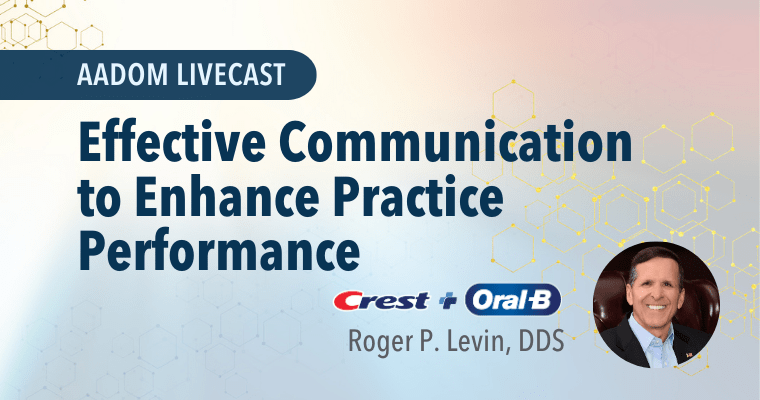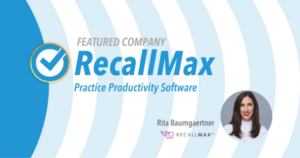AADOM QUICKcast: Breaking Barriers in Payments: The Future of Integration Through Automation
Video Description:
Are you leveraging the latest in patient-payments technology?
The visionary, yet immediately applicable insights gained in this QUICKcast will expose participants to the latest in patient-payment solutions and best practices, with a focus on incorporating AI-based automation technology to optimize payment workflows in a dental practice setting. Attendees will discover how robotics automation is transforming integration paradigms and pushing beyond traditional boundaries to help create a more efficient and patient-friendly payment experience as well as contribute to the overall effectiveness of the practice.
Course Learning Objectives:
- Discover how to enable “Uber-like” payment experiences for your practice
- Uncover new pathways to integrate patient payments with your practice management system
- Learn what’s possible in payments automation technology
- Leverage AI-based automation technology and the latest in digital payments to create unprecedented efficiencies
- And so much more!
Sponsored by: LQpay
Breaking Barriers in Payments – Future of Automation
Breaking barriers in the rapidly evolving landscape of dentistry has become synonymous with innovation and efficiency! Nowhere is this more evident than in the realm of patient payments, where the future is being shaped by the transformative power of automation.
This article explores the current state of payments, the challenges faced, and the groundbreaking solutions automation brings to the forefront, signaling a new era of seamless integration.
The Current Landscape: Challenges in Traditional Payments
Traditionally integrated healthcare payment systems have long been dominated by monopolistic business models, holding dental practices hostage to a singular solution. This has resulted in unnecessary complexities, added cost, and inefficiencies. From sub-par and/or limited functionality to inflated pricing, dental practices and patients alike have faced hurdles that hinder the smooth flow of financial transactions. The need for a paradigm shift has become increasingly evident, pushing the boundaries of what is possible in the world of patient payments.
Creating “Uber-Like” Payment Experiences:
The term “Uber-like” has been coined to characterize a frictionless, user-friendly experience. Applying this concept to patient payments means creating a system where users can process transactions effortlessly, with minimal steps and maximum convenience. Automation is at the forefront of realizing these “Uber-like” payment experiences, where payments become an integral and almost invisible part of the patient journey.
Through automated processes, payment experiences can be tailored to the preferences of users. Whether it’s recurring payments, “One-Click,” or “Zero-Click” transactions, automation allows dental practices to craft payment experiences that are not only efficient but also aligned with patient expectations.
Exploring Alternatives to PM System Payments Processing:
While practice management (PM) systems play a vital role in healthcare operations, there’s a growing need for alternatives in payments processing that offer greater flexibility and innovation.
The question arises: Can you adopt alternatives without sacrificing integration capabilities?
The answer lies in exploring patient-payment solutions which can complement PM systems and/or compensate for inherent limitations, and often at a lower cost. These alternatives often provide specialized features and customization options, catering specifically to the nuances of patient payments.
Integration with Practice Management Systems:
Breaking barriers in payments extends beyond mere transactional efficiency. It involves integrating payments seamlessly with practice management systems without dependencies on those underlying systems, many of which still deploy legacy technology with limited functionality around patient payments.
This is especially true in industries like dental and health care where most EMR/PM systems confine practices to their internal, proprietary processing systems to maintain integration by failing to open up embedded API’s. In doing so, they have preserved their own revenue streams, locked out competition, healthy for the industry and suppressed innovation.
Moreover, cutting-edge AI and Automation technologies have plowed a new road to achieve integration of patient payments with practice management systems, leveling the playing field for dental practices. By leveraging the latest in payments technology, coupled with today’s automation capabilities, dental providers can enhance the overall experience for both patients and office staff. From appointment handling to billing and post-adjudication payment collections, automation streamlines administrative tasks, allowing dental professionals to focus more on their patients.
Automation: A Game-Changer in Payments
Automation technologies such as those based on AI (Artificial Intelligence) and RPA (Robotics Processing Automation) emerge, offering a transformative approach to payments, breaking down barriers and introducing unprecedented efficiency. The key components of this game-changing revolution include:
- Streamlining Processes: From the auto-posting of all transaction types to A/R automation and leveraging cards on file, automation simplifies and streamlines payment processes, eliminating manual steps and reducing the risk of errors.
- Integration Across Platforms: Breaking barriers requires integration across diverse platforms. Marrying the right payments technology solution with automation capabilities enables seamless integration between disparate practice management systems. This new pathway to interoperability creates a unified patient payments ecosystem where transactions flow effortlessly, regardless of the platform or service provider. This is particularly beneficial for DSO’s, practices growing by acquisition, or multi-location practices using different PM systems across their offices.
- Complex Workflows: Automation doesn’t just improve the efficiency of “current state” processes; it also paves the way to implement more sophisticated workflows reliably, and without being cumbersome on staff members.
- Real-Time Transactions: The future of payments will become increasingly reliant on real-time transactions. Automation facilitates instantaneous payment options, providing practice and patients with the ability to transact at the speed of
Leveraging AI-Based Automation Technology: Beyond Posting Payments:
The integration of Artificial Intelligence (AI) takes automation to new heights. AI-based automation technology not only streamlines processes but also adds a layer of intelligence to payment systems. Machine learning algorithms analyze transaction patterns, detect anomalies, and continuously adapt to evolving trends, contributing to a more proactive and efficient payment ecosystem.
AI-driven automation is not confined to transaction processing alone, and as the healthcare industry evolves, there’s a burgeoning interest in AI-based automation that goes beyond the conventional realm of posting payments. AI brings a new dimension to patient payments by introducing capabilities only limited by our own imagination.
Realizing the Future: The Unprecedented Efficiencies of Automated Payments
The future of payments, shaped by automation, holds the promise of unprecedented efficiencies. As barriers continue to crumble, businesses and consumers can expect:
- Innovative Business Models: Breaking barriers in payments opens up avenues for innovative business models. Subscription-based services, pay-per-use models, and other flexible payment structures become more feasible with the efficiency and adaptability offered by automation.
- Acceleration of E-Commerce: As remote and online payments continue to thrive, automated payment solutions are integral to the acceleration of overall payment acceptance. Seamless checkouts, secure transactions, and personalized payment options contribute to a thriving digital marketplace.
- Reduced Transaction Costs: Automation leads to cost reductions associated with manual processing, human errors, and time delays. Businesses can streamline operations and allocate resources more efficiently, as well as reduce overall transaction costs.
- Payments ROI: Technology advancements are redefining the way dental practices view payments processing. Evolving from traditional, fee-based merchant processing to a true technology solution integral to the efficiency of the practice. Practices who embrace technology will realize a true return to their bottom line, along with enhanced patient satisfaction.
Conclusion: Breaking Barriers, Embracing the Future of Patient Payments
The future of payments lies in the hands of innovative technology. The integration of AI, digital payments, and evolved workflows positions robotics and automation in payments as catalysts for positive change. Dental practices must evaluate their current approaches and consider embracing advancements to drive value and provide alternatives to conventional payments processing, thereby breaking barriers and paving the way for a seamless, efficient, and innovative financial landscape.
Visit LQpay.ai to schedule a demo to see how their solution can help automate and streamline your patient payments process.
Learn about the presenter:

As a founding member on the leadership team, Amy Crawford is involved in all aspects of LQpay, including strategic growth initiatives, partnerships, sales and marketing, fulfillment, and product development. Before joining LQpay, Amy served as EVP, veEDIS Clinical Systems, a “best-of-breed” EHR for hospital emergency departments and CareTRAK™, a real-time, intelligent clinical decision support tool. Amy holds a bachelor’s in management from Florida State University. She is a member and serves on various boards of both professional- and industry-specific organizations and enjoys being involved in community activities.






